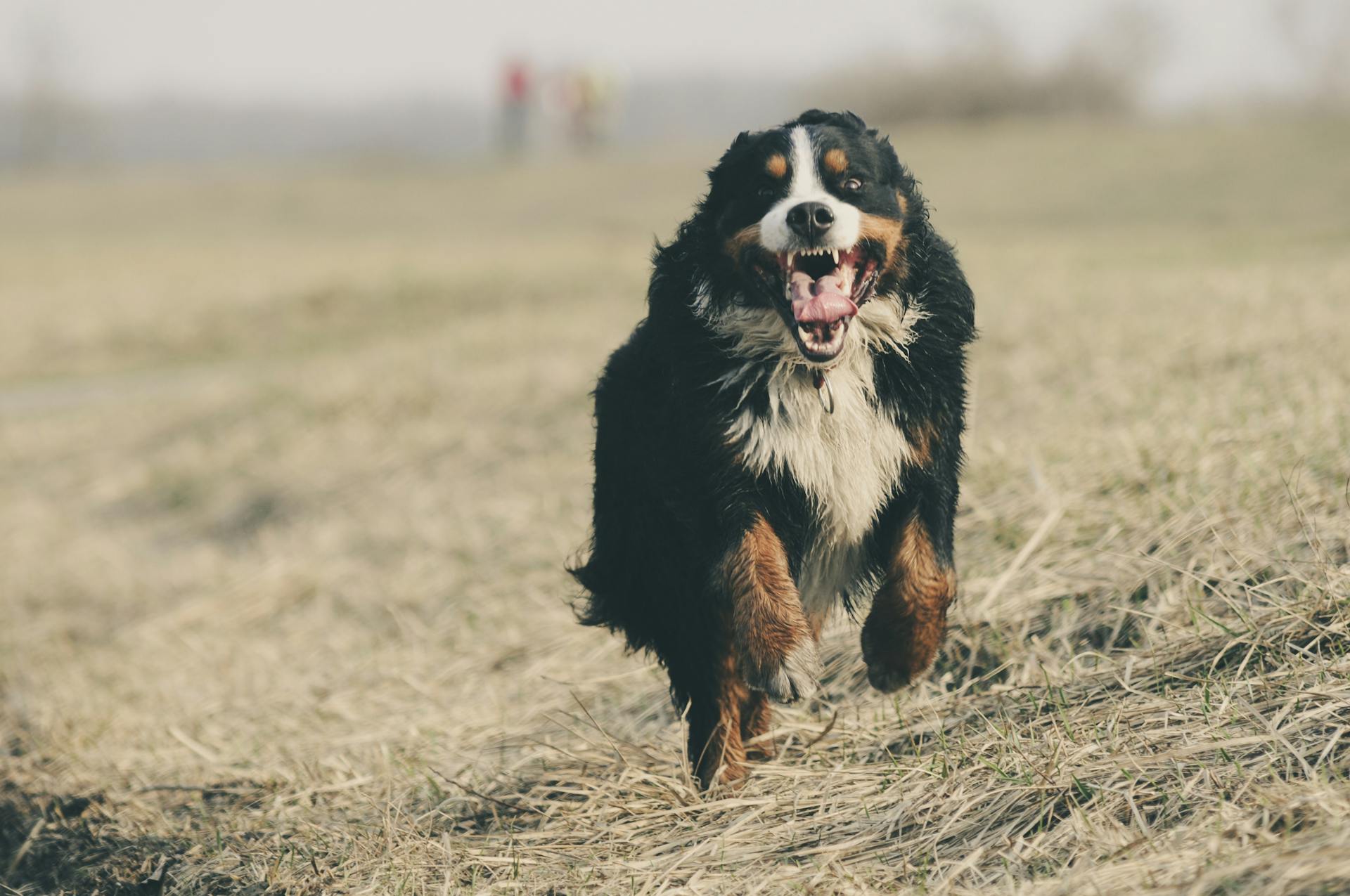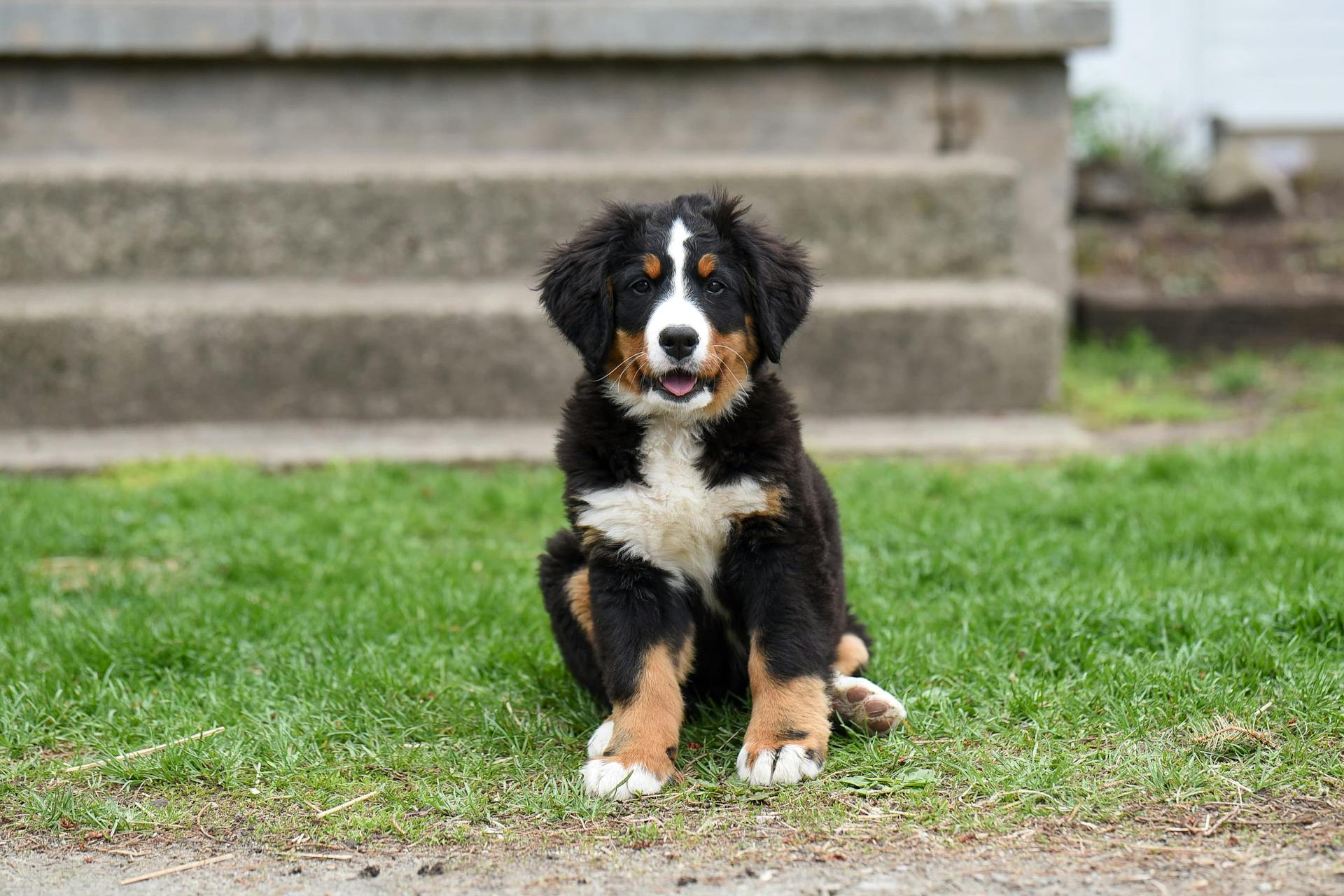
Bernese Mountain Dogs are prone to certain types of cancer, with osteosarcoma being one of the most common.
Osteosarcoma often starts as a small tumor on the end of a long bone, and can be difficult to detect in its early stages.
As a responsible pet owner, it's essential to be aware of the symptoms of osteosarcoma, which can include swelling or redness around the tumor, pain when moving the affected limb, and limping.
Early detection is crucial, as osteosarcoma can quickly spread to other parts of the body if left untreated.
Bernese Mountain Dogs are also at risk for hemangiosarcoma, a type of cancer that affects the blood vessels and can cause symptoms such as bleeding or bruising.
Hemangiosarcoma can be particularly challenging to diagnose, as the symptoms may not appear until the cancer has progressed.
Regular veterinary check-ups and monitoring for any unusual symptoms can help identify hemangiosarcoma in its early stages.
Recommended read: Turkey Tail Mushroom for Dogs Hemangiosarcoma
Cancer Risk
Bernese Mountain Dogs are prone to various types of cancer, and it's essential to understand the risks to provide the best possible care for your furry friend.
One in four dogs will develop malignant cancer in their lifetime, and for those 10 years old and older, that statistic rises to one in two. This means that many Bernese Mountain Dogs will be at risk of developing cancer.
Some common types of cancer in Bernese Mountain Dogs include histiocytic sarcoma, which is a genetic disease in this breed. In fact, up to 25% of Berners will develop histiocytic sarcoma.
Certain breeds are more susceptible to histiocytic sarcoma, and Bernese Mountain Dogs are among them. The breeds that are predisposed to localized histiocytic sarcoma include Bernese Mountain Dogs, Flat-Coated Retrievers, Labrador Retrievers, and Rottweilers.
Here are some breeds that are more susceptible to histiocytic sarcoma:
- Bernese Mountain Dogs
- Flat-Coated Retrievers
- Labrador Retrievers
- Rottweilers
- Golden Retrievers
Histiocytic sarcoma usually occurs in dogs 6-11 years of age, but it has been documented in dogs as young as three. Knowing the age range and breeds that are more susceptible can help you monitor your dog's health closely.
A genetic mutation has been identified in the Bernese Mountain Dog, which suggests a heritable element in the development of histiocytic sarcoma. This means that responsible breeding practices are crucial to reduce the risk of this disease.
Symptoms of Sarcoma
If your Bernese Mountain Dog is diagnosed with sarcoma, you'll likely notice a range of symptoms depending on the type and location of the tumor.
Localized sarcoma typically presents as a palpable mass on or under the skin, and the dog may not show any other signs of illness.
Dogs with disseminated sarcoma, on the other hand, may exhibit nonspecific symptoms such as decreased appetite, lethargy, and weight loss.
Fever, lesions on the skin, and swollen lymph nodes are also common in dogs with this type of sarcoma.
In some cases, sarcoma can cause more severe symptoms, including coughing or difficulty breathing, limping, and neurologic signs like disorientation and seizures.
Here are some common symptoms of sarcoma in Bernese Mountain Dogs:
- Decreased appetite
- Lethargy
- Weight loss
- Fever
- Lesions on the skin
- Coughing or difficulty breathing
- Limping
- Neurologic signs
- Swollen lymph nodes
- Bulging eyes
- Distended abdomen
Keep in mind that these symptoms can vary depending on the type and location of the tumor, and your veterinarian will need to perform a physical exam and run some tests to determine the best course of action.
Treatment Options
Treatment options for Bernese Mountain Dogs with cancer are often complex and require a multi-faceted approach.
Surgery can be effective for localized histiocytic sarcoma, especially when combined with chemotherapy. Aggressive surgical resection is recommended for localized tumors with wide margins and a deep margin of at least one fascial layer.
Chemotherapy is another important treatment option, with CCNU (lomustine) being considered the most effective chemotherapy for histiocytic sarcoma. Studies have shown a 46% response rate with CCNU, improving median survival times to 19 months for localized histiocytic sarcoma.
For dogs with disseminated histiocytic sarcoma, chemotherapy may prolong survival time, but the prognosis is still poor. Lomustine improved median survival times to 5.5 months for 54% of dogs in the study.
Radiation may be used to treat localized histiocytic sarcoma in several cases, including pre-operative irradiation of large tumors, post-operative irradiation of incompletely removed tumors, and palliative irradiation of inoperable tumors.
Radiation
Radiation is a treatment option for localized histiocytic sarcoma in several cases. Pre-operative irradiation of large tumors can be beneficial, as can post-operative irradiation of incompletely removed tumors. Palliative irradiation of inoperable tumors is also an option.
If this caught your attention, see: Canine Brain Tumors
Radiation is most effective when used in combination with surgery, but even in these cases, it's not a guarantee of a cure. For instance, dogs treated with palliative radiation and lomustine (CCNU) had a median survival time of approximately seven months.
Targeted radiation for internal masses has shown a moderate success rate, but it's not a cure. Dogs treated with radiation survived a median of 182 days, compared to 60 days for those who didn't receive radiation.
Here are some scenarios where radiation is recommended:
- Pre-operative irradiation of large tumors
- Post-operative irradiation of incompletely removed tumors
- Palliative irradiation of inoperable tumors
Immunotherapy
Immunotherapy has shown promise in treating certain types of cancer. Initial studies have been conducted on its use in disseminated histiocytic sarcoma.
T-cell therapy has been explored as a treatment option. Durable clinical remissions have been documented in four histiocytic sarcoma dogs treated with TALL-104.
Prolonged survival has been observed in these dogs.
Diet and Care
Bernese mountain dogs have a unique dietary need, which is to ensure their diet is complete and balanced, providing all the nutrients required by a dog.
A well-balanced diet is crucial, especially when your dog is fighting cancer. There are no supplements specifically recommended for histiocytic sarcoma, but a variety of foods, plants, and herbs support the immune system and may help in your dog's fight against cancer.
Regular exercise is essential for your Bernese mountain dog's overall health. They need at least a half-hour of moderate exercise daily, which can be achieved through activities like long walks and hiking.
To keep your dog's coat in good condition, regular brushing is necessary. They shed heavily, especially during shedding season, so weekly brushing is a must.
- Brush their coat weekly
- Trim their nails regularly
By following these simple care tips, you can help your Bernese mountain dog live a happy and healthy life, even with cancer.
Diet
Diet is a crucial aspect of your dog's overall health, especially when they have a condition like histiocytic sarcoma. A complete and balanced diet is essential to provide all the necessary nutrients.
There are no specific dietary recommendations for dogs with histiocytic sarcoma, so it's best to stick with a high-quality dog food that meets their nutritional needs. A variety of foods, plants, and herbs can support the immune system and help fight cancer.
To ensure your dog gets the nutrients they need, choose a dog food that's appropriate for their age and size. Be mindful of overfeeding, as this can lead to weight gain and other health issues.
Some foods to avoid giving your dog include table scraps, which can be unhealthy and even toxic. Regularly monitoring your dog's food intake and adjusting their diet as needed can help prevent these problems.
Here are some general guidelines for a healthy diet:
- Feed high-quality dog food appropriate to their age and size
- Avoid table scraps and unhealthy foods
- Monitor food intake and adjust as needed
Integrative Therapies
Integrative Therapies can be a valuable addition to your care plan. Physical therapy and rehabilitation, including hydrotherapy, treadmill, and passive range of motion exercises, may be helpful if movement is compromised, particularly following limb amputation.
Some people find acupuncture to be helpful for comfort levels. Acupuncture has not been studied for histiocytic sarcoma, but it can be worth exploring.
Acupuncture, acupressure, and traditional Chinese medicine may also be worth considering. There is anecdotal support for their use in targeting the tumor and the symptoms of cancer treatment.
Stats and Facts
Histiocytic sarcoma is a rare type of cancer that affects dogs, making up less than 1% of canine cancers of the lymphatic system.
This cancer is often found around dogs' joints, where it's the most common tumor. In fact, 18.3% of cases are located in the bone or joints.
Histiocytic sarcoma can also affect the brain, accounting for 5% of primary brain tumors and 4.5% of metastatic brain tumors in dogs.
There are three subtypes of histiocytic sarcoma: localized histiocytic sarcoma, disseminated histiocytic sarcoma, and hemophagocytic histiocytic sarcoma.
Here's a breakdown of the subtypes and their locations:
It's worth noting that while these statistics are specific to histiocytic sarcoma, they can provide insight into the types of cancers that affect Bernese Mountain Dogs.
Bernese Mountain Dog Health
The Bernese Mountain Dog is a breed that's particularly prone to cancer, and histiocytic sarcoma is a type of cancer that affects them specifically. This cancer usually occurs in dogs between 6-11 years of age.
Bernese Mountain Dogs are one of the breeds most commonly affected by histiocytic sarcoma, and they're also more susceptible to disseminated histiocytic sarcoma, a more aggressive form of the disease. This breed has a higher risk of developing cancer than many others.
If you're a Bernese Mountain Dog owner, it's essential to be aware of these risks and work closely with your veterinarian to monitor your dog's health. You can also bookmark some valuable resources, such as the UC Davis Histiocytosis pages and the Bernese Mountain Dog Club of America's health studies information.
Canine Sarcoma Risk Factors
Canine sarcoma is a serious health issue in Bernese Mountain Dogs. Research suggests that certain breeds, including Bernese Mountain Dogs, are more prone to developing histiocytic sarcoma, a type of cancer.
Readers also liked: Histiocytic Sarcoma Bernese Mountain Dog

The breeds most affected by histiocytic sarcoma include Bernese Mountain Dogs, Flat-Coated Retrievers, Labrador Retrievers, Rottweilers, and Golden Retrievers. These breeds are more susceptible to developing this disease.
Bernese Mountain Dogs have a higher risk of developing histiocytic sarcoma, with up to 25% of Berners affected. This is a genetic disease, and research suggests that it is inherited.
A study initiated in 1989 found that 25.4% of tumors collected from Bernese Mountain Dogs were histiocytic. The study also determined that if either parent had a histiocytic disease, the risk increased to 1 in 4.5.
If you're a Bernese Mountain Dog owner, it's essential to be aware of the risk factors for histiocytic sarcoma. Your veterinarian can help you identify any potential issues and recommend diagnostic tests.
Here's a list of breeds that are more susceptible to histiocytic sarcoma:
- Bernese Mountain Dogs
- Flat-Coated Retrievers
- Labrador Retrievers
- Rottweilers
- Golden Retrievers
Early detection is crucial in treating histiocytic sarcoma. Your veterinarian may recommend advanced laboratory testing, such as immunophenotyping and immunohistochemistry, to diagnose the disease definitively.
Traits
Bernese Mountain Dogs are a large breed, with males growing to be between 25 and 27.5 inches tall.
Their size can make them a bit more challenging to care for, especially in smaller living spaces. Males weigh between 80 to 115 pounds, while females weigh 70 to 95 pounds.
Despite their size, Bernese Mountain Dogs are intelligent and agile dogs, bred for working in the mountainous region they originated from.
Their intelligence and strong work ethic make them a great breed for active families who can provide them with plenty of exercise and attention.
With proper care and attention, Bernese Mountain Dogs can live between seven and ten years, making them a long-term companion for many families.
Their friendly and outgoing personalities make them a great addition to any household, and their nobility and intelligence are traits that are truly special.
Discover more: Bernese Mountain Dog Adult
Size
Size is a crucial factor in determining a dog's lifespan. Large dogs tend to die sooner than small dogs due to problems like cancer.
In fact, research has shown that large dogs grow quicker and therefore develop more abnormal cell production than small dogs do. This can lead to a shorter lifespan and more age-related illnesses.
As a result, large dogs like the Bernese Mountain Dog may experience age-related illnesses earlier in life than small dogs would.
Curious to learn more? Check out: Small Water Dogs
Life Stages
Understanding the life stages of a Bernese Mountain Dog is crucial to knowing how much longer your pet has left to live. There are four major life stages to be aware of.
Puppies are born after a gestation period of about 60-64 days, and they typically weigh between 1-2 pounds at birth.
The first life stage is the puppy stage, which lasts from birth to about 12-18 months.
During this stage, Bernese Mountain Dogs grow rapidly, with an average weight gain of 2-3 pounds per week.
The second life stage is the adolescent stage, which lasts from 1-2 years.
Discover more: Lifespan of an Irish Wolfhound
At this stage, Bernese Mountain Dogs continue to grow and develop physically, but they also start to develop their adult personality.
The third life stage is the adult stage, which lasts from 2-7 years.
Bernese Mountain Dogs typically reach their full physical maturity during this stage.
The fourth and final life stage is the senior stage, which lasts from 7-10 years.
At this stage, Bernese Mountain Dogs may start to experience age-related health issues, such as joint problems and hearing loss.
If this caught your attention, see: Bull Terrier 100 Years Ago
Disease Experiences and Recommendations
Bernese Mountain Dogs are prone to cancer, with 60% of the breed developing some form of cancer.
Regular veterinary check-ups can help detect cancer early, making treatment more effective.
According to the article, cancer is a major health concern for Bernese Mountain Dogs, with a significant percentage of the breed affected.
Early detection and treatment can greatly improve a dog's chances of survival and quality of life.
Some common types of cancer in Bernese Mountain Dogs include osteosarcoma, mast cell tumors, and lymphoma.
Disease Experiences

Living with a Bernese Mountain Dog can be a wonderful experience, but it's essential to be aware of the potential health issues they may face. Histiocytic Diseases, particularly Histiocytic Sarcoma, are a significant concern for this breed.
This disease is more common in Bernese Mountain Dogs than in other breeds, and it's crucial to know the signs and symptoms to catch it early. According to Benoit Hedan & Catherine Andre's research, Histiocytic Sarcoma in BMDs is a genetic condition that has seen significant progress in recent years.
If you're a Bernese Mountain Dog owner, it's essential to be aware of the risks and take preventative measures. Keeping your dog's environment clean can help reduce the risk of disease.
The University of California, Davis, has a wealth of information on Histiocytosis, including current research and studies. You can find more information on their website at http://www.histiocytosis.ucdavis.edu/.
For more insights, see: Histiocytosis Bernese Mountain Dog
History
Bernese Mountain dogs have a rich history that dates back to the canton of Bern in Switzerland, where they were bred to protect farmyards and drive cattle.

They were incredibly strong, able to pull many times their own weight, making them perfect for draft work and hauling carts around the Swiss Alps.
In the late 1800s, the breed was in decline, but thanks to a Swiss breed club, Bernese Mountain dogs became popular household companions and farm dogs by the early 1900s.
A Kansas farmer introduced Bernese Mountain dogs to America in 1926, and by 1937, they were officially recognized by the American Kennel Club.
Their lifespan may be short, but Bernese Mountain dogs have made a lasting impact on the families who've had the pleasure of sharing their lives with them.
Recommendations
To reduce the incidence of histiocytic disease in Bernese Mountain Dogs, accurate diagnosis is imperative. This requires a biopsy or necropsy with consistent pathology determination.
Sharing the information received from accurate diagnosis is essential. Entering the results into open databases like Berner-Garde allows breeders to make informed breeding decisions.

Educating owners to acquire and share accurate diagnoses is an ongoing process. This involves learning about the importance of biopsy or necropsy and consistent pathology determination.
Accurate diagnosis is critical for making informed breeding decisions. This means that breeders need to have access to reliable information about the health status of their breeding stock.
Entering accurate diagnoses into open databases like Berner-Garde is necessary. This helps breeders identify and avoid breeding dogs with a history of histiocytic disease.
Genetic testing may one day help eliminate histiocytic disease from the Bernese Mountain Dog breed. For now, education and knowledge are our best tools for reducing the incidence of this disease.
The Berner-Garde database and the BG/MI State DNA/tissue repository are excellent resources for advancing our understanding of histiocytic disease.
Additional reading: Bull Terrier before Breeding
Frequently Asked Questions
What is the most common cause of death in Bernese mountain dogs?
Cancer is the leading cause of death in Bernese mountain dogs, with a higher rate of fatal cancer compared to other breeds.
How long do dogs live with hemangiosarcoma?
Dogs with hemangiosarcoma typically live 1-3 months with surgery alone, and 5-7 months with surgery and chemotherapy, but unfortunately, the prognosis is generally poor with a high mortality rate within 1-2 years
What are the first symptoms of cancer in dogs?
Common early signs of cancer in dogs include lumps, abnormal odors, and changes in appetite, energy, and bathroom habits. If you notice any of these symptoms, consult a veterinarian for a proper diagnosis and treatment
What are the symptoms of malignant histiocytosis in Bernese mountain dogs?
Bernese mountain dogs with malignant histiocytosis may exhibit symptoms such as weight loss, lethargy, and loss of appetite, as well as more specific signs like difficulty breathing, neurological issues, and swollen lymph nodes. If you suspect your dog is showing these symptoms, it's essential to consult a veterinarian for proper diagnosis and treatment.
What is the rare cancer in Bernese mountain dogs?
Bernese Mountain Dogs are prone to a rare genetic cancer called histiocytic sarcoma, with up to 25% of the breed affected. Learn more about this serious health issue affecting Berners.
Sources
- https://www.thevetiverse.com/en/latest/dog-breeds-and-cancer-which-dogs-have-increased-risk/
- https://www.dogcancer.com/articles/types-of-dog-cancer/histiocytic-sarcoma-dog/
- http://www.bmdinfo.org/Health/Histiocytic_Diseases_of_the_Bernese_Mountain_Dog.php
- https://www.webmd.com/pets/dogs/what-to-know-about-bernese-mountain-dogs
- https://www.dogster.com/dog-health-care/bernese-mountain-dog-lifespan-how-long-do-they-live
Featured Images: pexels.com
